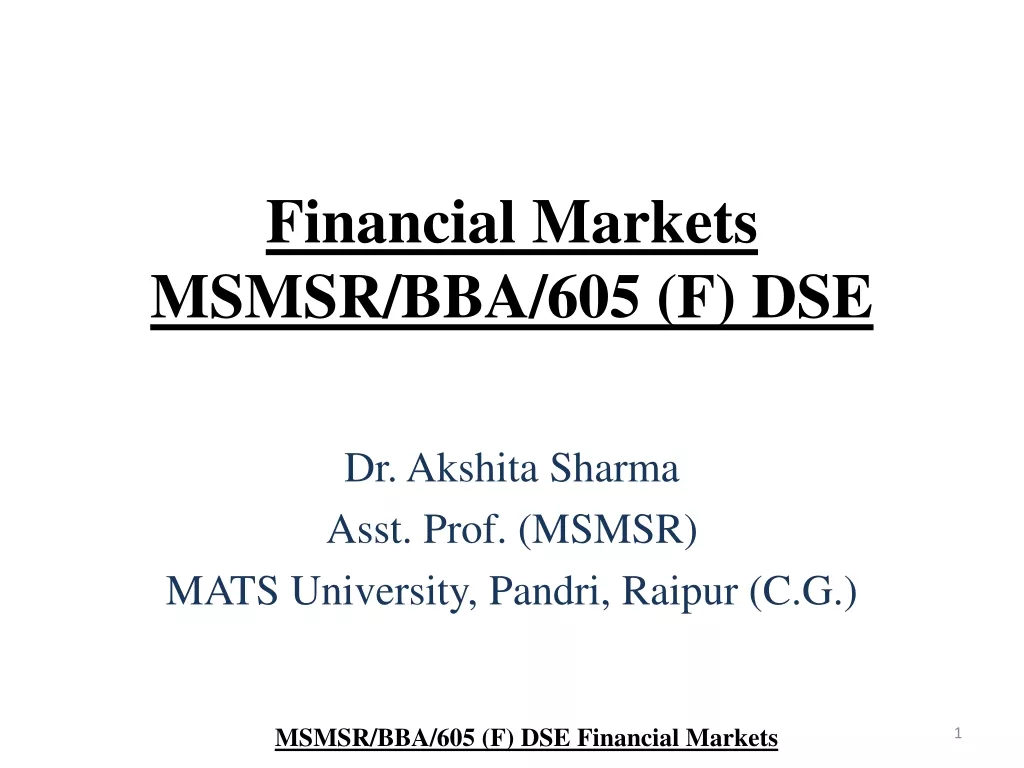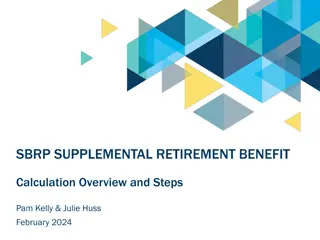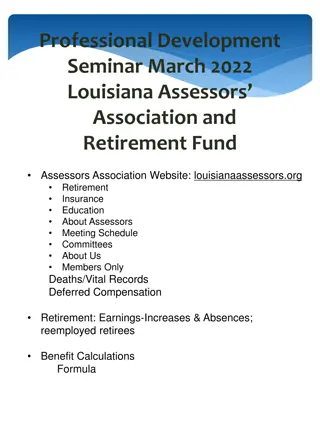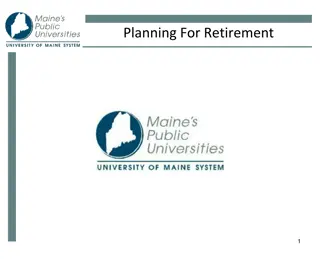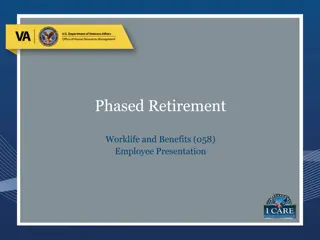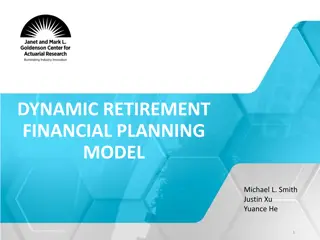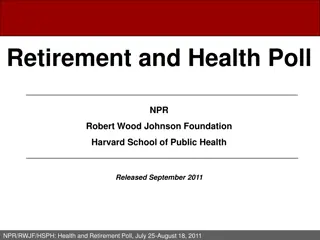Global Aging and Retirement Security in Emerging Markets
The world is experiencing a significant demographic shift towards global aging, with the elderly population expected to increase in various countries by 2050. This transformation is primarily driven by falling fertility rates and rising life expectancies. The funded pension model is highlighted as advantageous, offering a more sustainable approach to income replacement as societies age. The rising old-age dependency ratio emphasizes the importance of transitioning towards funded pension systems for better financial security.
Download Presentation

Please find below an Image/Link to download the presentation.
The content on the website is provided AS IS for your information and personal use only. It may not be sold, licensed, or shared on other websites without obtaining consent from the author.If you encounter any issues during the download, it is possible that the publisher has removed the file from their server.
You are allowed to download the files provided on this website for personal or commercial use, subject to the condition that they are used lawfully. All files are the property of their respective owners.
The content on the website is provided AS IS for your information and personal use only. It may not be sold, licensed, or shared on other websites without obtaining consent from the author.
E N D
Presentation Transcript
Global Aging and Retirement Security in Emerging Markets: Reassessing the Role of Funded Pensions Richard Jackson President Global Aging Institute A policy forum hosted by the Global Aging Institute & Principal Financial Group November 18, 2015 American Council of Life Insurers Washington, DC
The world stands on the threshold of a stunning demographic transformation called global aging. Elderly (Aged 65 & Over), as a Percent of the Population in 2010 and 2050 5% 8% India China 13% 25% 2010 5% 17% Indonesia France 16% 26% 2050 6% 14% Mexico Canada 20% 26% 13% 9% US Thailand 21% 30% 13% 14% Australia Poland 22% 32% 13% 21% Russia Germany 22% 34% 7% 20% Brazil Italy 23% 35% 9% 11% Chile S. Korea 25% 38% 17% 23% UK Japan 25% 39% 0% 10% 20% 30% 40% 50% 0% 10% 20% 30% 40% 50% Source: World Population Prospects: The 2012 Revision (UN Population Division, 2013) 2
Two forces behind the demographic transformation: Falling fertility and rising life expectancy. Total Fertility Rate and Life Expectancy at Birth, 1950-2015 Total Fertility Rate Life Expectancy at Birth 1950-55 1970-75 1990-95 2010-15 1950-55 1970-75 1990-95 2010-15 East Asia 6.0 4.7 2.0 1.6 44.8 64.6 70.2 75.5 Eastern Europe 2.9 2.2 1.6 1.4 59.9 69.1 68.3 70.0 Greater Middle East 6.6 6.2 4.6 3.0 44.6 56.0 65.6 70.2 Latin America 5.9 5.1 3.0 2.2 52.1 61.4 69.2 74.8 South Asia 5.9 5.5 3.5 2.4 39.2 52.0 61.6 68.2 Sub-Saharan Africa 6.4 6.6 6.1 5.2 36.8 44.6 50.0 58.0 Source: UN Population Division (2013) 3
Advantages of the Funded Model 4
A rising old-age dependency ratio translates directly into a rising PAYGO cost rate. Income Replacement As societies age, funded pension systems will be able to deliver the same replacement rate at a lower contribution rate than PAYGO systems can or, conversely, a higher replacement rate at the same contribution rate. Aged Dependency Ratio: Number of Elderly (Aged 65 & Over) per 100 Working-Age Adults (Aged 20- 64) in 2010 and 2050 80 76 2010 70 2050 59 58 60 50 45 44 40 38 40 35 27 30 21 21 20 17 20 15 14 13 12 11 9 9 10 0 Source: UN Population Division (2013) 5
Income Replacement When workforces grow more slowly or contract, the rate of return advantage shifts to the funded model. Average Annual Growth Rate in the Working-Age Population (Aged 20-64), by Decade, 1980s-2040s 1980s 1990s 2000s 2010s 2020s 2030s 2040s Brazil 2.9% 2.4% 2.0% 1.2% 0.5% 0.0% -0.4% Chile 2.6% 1.9% 1.7% 1.1% 0.1% 0.0% -0.1% China 2.9% 1.8% 1.6% 0.4% -0.3% -0.8% -0.9% India 2.6% 2.4% 2.2% 1.7% 1.2% 0.8% 0.3% Indonesia 3.0% 2.6% 1.9% 1.6% 1.2% 0.4% 0.1% Mexico 3.1% 3.1% 2.0% 1.8% 1.2% 0.4% 0.0% Poland 0.6% 0.4% 0.8% -0.6% -0.9% -0.7% -1.8% Russia 0.7% 0.1% 0.5% -0.7% -1.0% -0.6% -1.4% S. Korea 2.9% 1.4% 0.8% 0.5% -0.9% -1.3% -1.3% 3.6% 2.1% 1.3% 0.3% -0.6% -1.2% -1.3% Thailand Source: UN Population Division (2013) 6
INDIA: Stylized Replacement Rate Projections Income Replacement Personal Accounts Replacement Rates in 2050 versus Affordable PAYGO Replacement Rates, Assuming the Same 12.5 Percent Contribution Rate* Real Wage Growth Rate When both the workforce and real wages are growing rapidly, PAYGO systems may outperform funded systems. FUNDED 5.0% 4.0% 30% 2.0% 1.0% 3.0% 26% 31% 37% 44% 54% 3.5% Real Rate of Return 29% 35% 42% 51% 63% Outperforms PAYGO 4.0% 33% 40% 48% 59% 73% In India, a PAYGO system would deliver higher replacement rates than a funded system under most real wage growth and rate of return assumptions. 4.5% 38% 45% 55% 68% 84% 5.0% 43% 52% 63% 78% 98% 5.5% 49% 59% 72% 90% 114% 6.0% 55% 68% 84% 105% 133% PAYGO 80% 74% 68% 63% 58% *Personal accounts projections assume a 40-year career, retirement at age 65, and administrative fees equal to 0.5 percent of assets. PAYGO projections assume retirement at age 65 and price indexation of current benefits. Source: GAI calculations 7
CHILE: Stylized Replacement Rate Projections Income Replacement Personal Accounts Replacement Rates in 2050 versus Affordable PAYGO Replacement Rates, Assuming the Same 12.5 Percent Contribution Rate* Real Wage Growth Rate As populations age and wage growth slows, funded systems gain a decisive advantage. FUNDED 3.0% 2.5% 2.0% 1.5% 1.0% 3.0% 26% 29% 32% 35% 39% 3.5% Real Rate of Return 30% 34% 37% 41% 46% Outperforms PAYGO In Chile, a funded system would deliver higher replacement rates than a PAYGO system under almost any reasonable set of real wage growth and rate of return assumptions. 4.0% 35% 39% 43% 48% 54% 4.5% 41% 46% 51% 57% 63% 5.0% 48% 53% 60% 67% 75% 5.5% 56% 62% 70% 78% 88% 6.0% 65% 73% 82% 92% 105% PAYGO 35% 33% 32% 30% 28% *Personal accounts projections assume a 40-year career, retirement at age 65, and administrative fees equal to 0.5 percent of assets. PAYGO projections assume retirement at age 65 and price indexation of current benefits. Source: GAI calculations 8
SOUTH KOREA: Stylized Replacement Rate Projections Income Replacement Personal Accounts Replacement Rates in 2050 versus Affordable PAYGO Replacement Rates, Assuming the Same 12.5 Percent Contribution Rate* Real Wage Growth Rate In the most rapidly aging countries, where workforces are actually contracting, the advantage of funded systems becomes overwhelming. FUNDED 3.0% 2.5% 2.0% 1.5% 1.0% 3.0% 25% 28% 30% 34% 37% 3.5% Real Rate of Return 29% 32% 36% 40% 44% Outperforms PAYGO 4.0% 34% 38% 42% 46% 52% In South Korea, there is no reasonable scenario in which a funded system would fail to deliver higher replacement rates than a PAYGO system. 4.5% 40% 44% 49% 55% 61% 5.0% 46% 52% 58% 65% 73% 5.5% 54% 61% 68% 76% 86% 6.0% 64% 71% 80% 90% 102% PAYGO 21% 20% 19% 18% 17% *Personal accounts projections assume a 40-year career, retirement at age 65, and administrative fees equal to 0.5 percent of assets. PAYGO projections assume retirement at age 65 and price indexation of current benefits. Source: GAI calculations 9
Income Replacement CHILE and SOUTH KOREA: Stylized PAYGO Contribution Rate Projections PAYGO Contribution Rates Required in Chile and South Korea to Deliver the Same Replacement Rate as a 12.5 Percent Personal Accounts Contribution Rate, 2015-2050* 30% 26% Chile: PAYGO Contribution Rate 24% 25% South Korea: PAYGO Contribution Rate 21% 20% Personal Accounts Contribution Rate 20% 18% 18% 17% 16% 14% 15% 14% 12.5 Percent 11% 11% 9% 10% 9% 8% 7% 5% 0% 2015 2020 2025 2030 2035 2040 2045 2050 *Personal accounts projections assume real wage growth of 2.0 percent, a real rate of return of 4.5 percent, a 40-year career, retirement at age 65, and administrative fees equal to 0.5 percent of assets. PAYGO projections assume 2.0 percent real wage growth, retirement at age 65, and price indexation of current benefits. Source: GAI calculations 10 9
Low coverage is explained by the size of a country s informal sector, not its type of pension system. Poverty Protection Effective Pension Coverage Rate and Size of the Informal Sector* in the Most Recent Available Year Whether its contributory pension system is funded or PAYGO, emerging markets with large informal sectors need a noncontributory social pension. 100% Singapore 90% Effective Pension Coverage Rate South Korea 80% Chile 70% Malaysia 60% The overall retirement system in countries with personal accounts systems can be made as progressive as desired. 50% Brazil 40% Peru Funded State Pension System PAYGO State Pension System Mexico 30% 20% Philippines 10% 0% 0% 20% 40% 60% 80% Size of the Informal Sector *The informal sector is defined as informal employment as a share of total non-agricultural employment. Source: Donghyun Park, ed., Pension Systems and Old-Age Income Support in East and Southeast Asia (ADB, 2012), 114 and 129; World Social Protection Report 2014/15 (ILO, 2014), 270; AIOS Statistical Bulletin (2012); Is Informal Normal? (OECD, 2009), 34-35; Friedrich Schneider, The Shadow Economy and Work in the Shadow, IZA Discussion Paper no. 6423 (Institute for the Study of Labor, March 2012), 55; Melisa R. Serrano, ed., Between Flexibility and Security (ASEAN Services Employees Trade Unions Council, 2014), 60 and 108; and national government pension authorities and statistical offices 11
Many aging developed countries have greatly reduced the future generosity of their PAYGO pension systems. Market Risk vs. Political Risk CumulativePercentage Reduction in Current-Law PAYGO Pension Benefits to the Elderly (Aged 60 & Over) Relative to "Current-Deal Benefits,* from2010 to 2040 Unlike market risk in funded systems, there is no proven strategy for minimizing political risk in PAYGO systems. Netherlands -5% Sweden -19% Political risk grows steadily as populations age and the cost of PAYGO benefits rises. US -22% Australia -24% UK -26% France -33% Canada -33% Germany -37% Japan -39% Italy -46% 0% -10% -20% -30% -40% -50% *The projections of "current-deal" benefits assume that retirement ages and replacement rates remain unchanged in the future. Source: Richard Jackson, Lessons from Abroad for the U.S. Entitlement Debate (CSIS, 2013) 12
Pension assets are growing rapidly as a share of GDP in countries with personal accounts systems. The Broader Economy Assets of Personal Accounts Systems, as a Percent of GDP, 1981-2014 70% While emerging markets are still young, funded pension systems can help them advance the development agenda by broadening and deepening capital markets. 60% Chile 50% Peru 40% As emerging markets age, funded systems, depending on how they are structured and financed, may also help to take pressure off public budget and maintain adequate rates of savings and investment. Colombia 30% Mexico 20% 10% 0% 198119841987199019931996199920022005200820112014 Source: Historical Statistics on Mandatory Savings (International Federation of Pension Fund Administrators, December 2014) 13
Design Challenges for Personal Accounts Systems 14
Contribution Rates Low contribution rates mean inadequate benefits. Personal Accounts Replacement Rates for Full-Career Workers in the Year 2050, by Contribution Rate 80% 71% 70% 61% 60% Replacement Rate 51% 50% 41% 40% 30% 30% 20% 10% 0% 7.5% 10.0% 12.5% 15.0% 17.5% Contribution Rate *The projections assume real wage growth of 2.0 percent, a real rate of return of 4.5 percent, a 40-year career, administrative fees equal to 0.5 percent of assets, retirement at age 65, and life expectancy at retirement of 23 years. Source: GAI calculations 15
Private vs. Public Management Privately managed systems outperform publicly managed ones. Average Annual Real Rate of Return on Assets under Management While the advantages of public and private responsibility for plan administration and recordkeeping are at least debatable, there is no question that privately managed pension funds outperform publicly managed ones. 7.6% 8% 7.5% 7% Publicly Managed 5.8% 5.6% 6% 5.5% Privately Managed 5% 4.1% 4.1% 3.7% 4% 3.4% 3% Public management of pension fund assets also invites government interference in financial markets and creates ambiguity about who owns the assets workers or government. 2% 1% 0% *Estimated based on nominal rate of return data. Source: FIAP Historical Statistics (December 2014); Latin American Economic Outlook 2008 (OECD, 2007), 88; and national government pension authorities 16
Higher returns may offset higher administrative fees. Administrative Fees Percent Reduction in Potential Personal Accounts Balance at Retirement, by Level of Administrative Fees* Since administrative fees reduce ultimate account balances and replacement rates, minimizing them has understandably become a focus of reform. 0.25% 0.50% 0.75% 1.00% 0% -5% -5.4% -10% -10.4% -15% -15.1% Policymakers, however, should not lose sight of the fact that what ultimately determines pension system adequacy is the net return earned by participants, and this also depends on investment performance. -20% -19.5% -25% *Administrative fees are calculated as a percent of assets. The projections assume a 12.5 percent contribution rate, real wage growth of 2.0 percent, a real rate of return of 4.5 percent, and a 40-year career. Source: GAI calculations Percent Increase in Potential Personal Accounts Balance at Retirement, by Real Rate of Return, Compared with the Potential Balance Assuming a 4.5Percent Real Rate of Return* The higher total return typically earned by privately managed systems may more than offset their higher administrative fees. 30% 24.8% 18.0% 20% 11.6% 10% 5.6% 0% 4.75% 5.00% 5.25% 5.50% *The projections assume a 12.5 percent contribution rate, real wage growth of 2.0 percent, a 40-year career, and administrative fees equal to 0.5 percent of assets. Source: GAI calculations 17
Most personal accounts systems are diversifying their portfolios. Portfolio Restrictions Assets by Investment Class in Selected Countries with Personal Accounts Systems Over time, personal accounts systems should move toward a prudent man investment rule. Financial Institution Debt Other Domestic Debt Government Debt Foreign Investment Asset allocation rules that overload portfolios with government debt or restrict foreign investment undermine the fundamental purpose of any pension system, which is obtaining the highest risk-adjusted return for participants. 2000 2012 2000 2012 2000 2012 2000 2012 36% 22% 35% 17% 18% 25% 11% 36% Chile Colom- bia* 49% 44% 17% 6% 28% 36% 7% 15% 93% 58% 2% 2% 5% 26% 0% 14% Mexico As emerging markets age, global diversification of portfolios will become even more important. 9% 17% 34% 12% 50% 44% 7% 28% Peru *Data for Columbia refer to 2004 and 2012. Includes a small category of unclassified assets. Source: AIOS Statistical Bulletin (various years) 18
Conclusion 19
Main Conclusions of the Report Funded pension systems have potentially important advantages over PAYGO systems in aging emerging markets. At the micro level, they will enjoy a widening rate of return advantage over PAYGO systems. At the macro level, they can foster the development of capital markets and, depending on how they are structured and financed, may help to take pressure off government budgets and maintain adequate rates of savings and investment. Although funded pension systems are an essential part of any overall strategy to confront the aging challenge, they alone cannot be the whole strategy. Every emerging market also needs to put in place a robust floor of old-age poverty protection, or social pension. The aging and development challenges facing today s emerging markets are inextricably linked. In the end, genuine retirement security can only be achieved if countries succeed in expanding the reach of their contributory pension systems. This in turn will require broader economic and social reforms that reduce inequality and increase the size of the formal sector. Funded pension systems must be well designed to realize their potential benefits. Inadequate contribution rates, high administrative fees, overly restrictive portfolio allocation rules, or the failure to annuitize account balances can all undermine the adequacy of funded pension systems. Yet as the second generation reforms of Latin America s personal accounts system demonstrate, it is possible to improve the equity and efficiency of the personal accounts model without sacrificing its underlying economic advantages. GLOBAL AGING INSTITUTE www. GlobalAgingInstitute.org Meanwhile, PAYGO pension systems face an unavoidable trade-off between adequacy and sustainability that has no satisfactory remedy. 20





